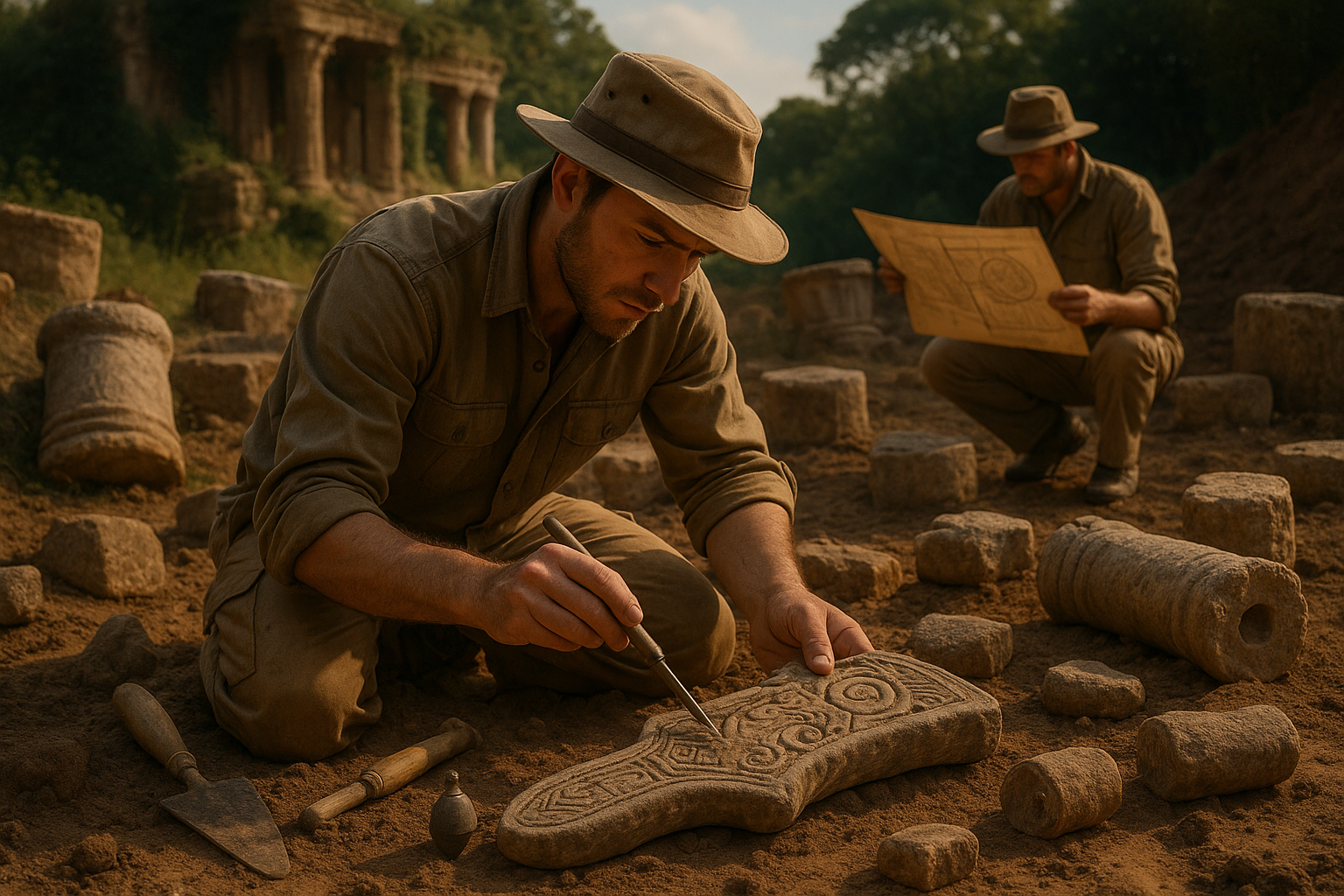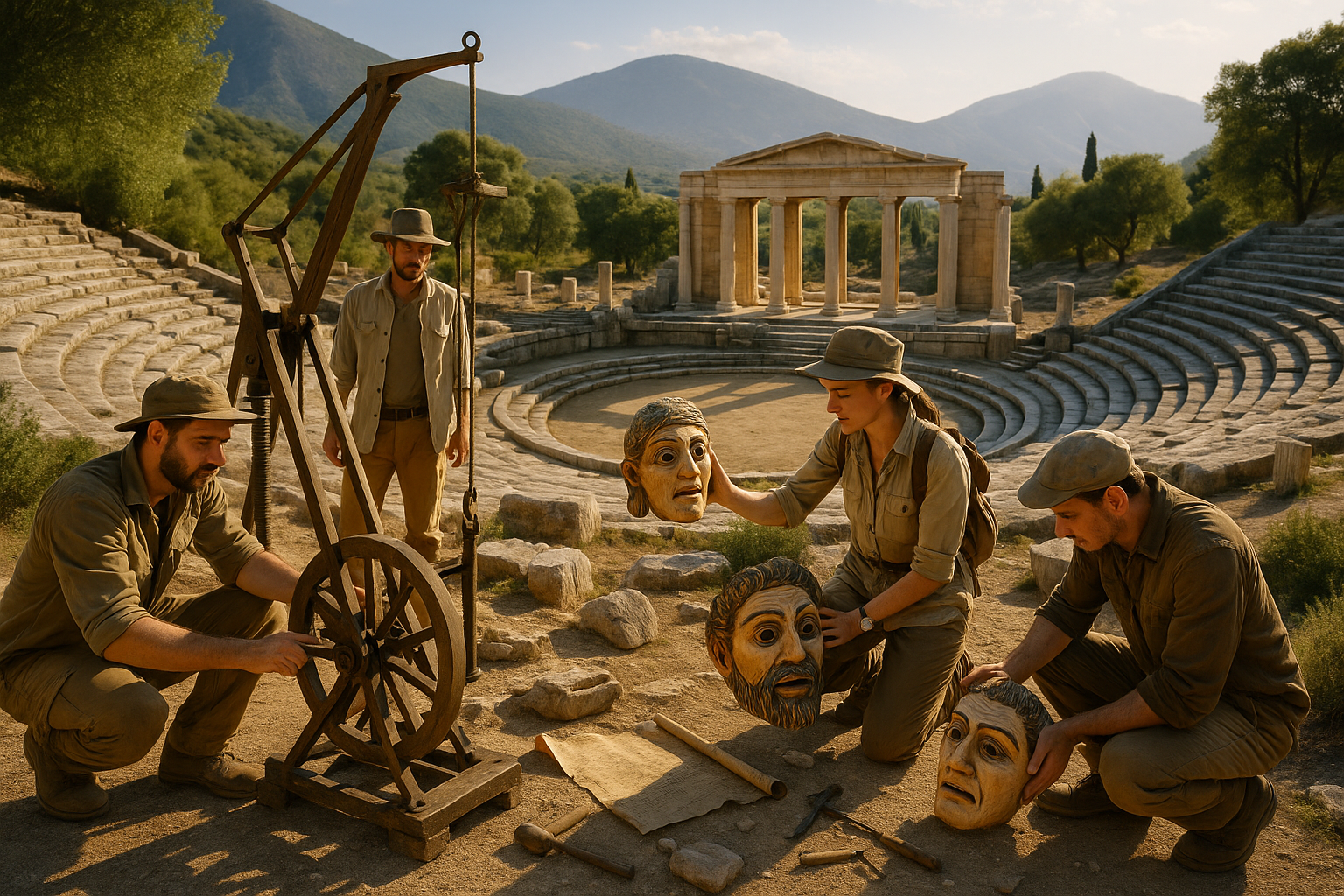In a world where technology evolves at breakneck speed, it’s easy to overlook the marvels of ancient engineering. Yet, these age-old mysteries continue to captivate us, whispering tales of innovation, culture, and spirituality from times long past. 🌍 Among these enigmas are the sacred construction tools and techniques that ancient civilizations employed to erect monumental structures, defying logic and gravity with their precision and grandeur.
Imagine standing before the towering pyramids of Egypt, the intricate stonework of Machu Picchu, or the mysterious Moai statues of Easter Island. How did ancient builders achieve such feats without the modern tools and machinery we rely on today? This question sparks a sense of wonder and curiosity, urging us to dig deeper into the secrets buried beneath layers of history.
In this comprehensive exploration, we’ll embark on a journey to unearth the mysteries surrounding these forgotten sacred construction tools. We will delve into the ancient techniques that allowed our ancestors to create structures that have withstood the test of time. From the mystifying methods of stone transportation to the precise alignment of structures with celestial bodies, we’ll unravel the secrets of these bygone engineering marvels.
The Role of Sacred Tools in Ancient Architecture
To understand the significance of sacred construction tools, we must first appreciate their role in ancient societies. These tools were not merely functional; they held spiritual significance, often believed to be imbued with divine power. ✨ They were crafted with care, using materials that were thought to enhance their potency. Our journey will uncover how these tools were used in rituals and ceremonies, reflecting the deep connection between construction and the cosmos.
Stone Transportation and Placement: Defying Gravity
One of the most intriguing aspects of ancient construction is the transportation and placement of massive stones. How did civilizations like the Egyptians and the Incas move these colossal blocks across great distances? We’ll examine theories and evidence that suggest a combination of ingenuity, manpower, and possibly even forgotten technologies. From sledges to rolling logs and beyond, discover the fascinating techniques that defied the limitations of the era.
Celestial Alignment: Architecture in Harmony with the Stars
The ancients were keen observers of the skies, and their architectural feats often reflect this celestial fascination. Many structures were aligned with astronomical events, such as solstices and equinoxes, demonstrating a sophisticated understanding of the cosmos. We will explore how sacred construction tools played a role in achieving such precise alignments, turning stone and earth into instruments of timekeeping and spiritual connection.
The Legacy of Lost Techniques: Modern Implications
As we uncover the secrets of these ancient methods, we’ll also consider their relevance today. What can modern architects and engineers learn from these forgotten techniques? How might these insights inspire sustainable building practices and innovative solutions in our own time? The legacy of these ancient builders offers not only a glimpse into the past but also a blueprint for the future. 🏛️
Join us as we peel back the layers of history to reveal the ingenuity and spirituality woven into the fabric of these monumental structures. This exploration promises to enlighten, inspire, and perhaps even challenge our understanding of what is possible when human creativity and determination come together. As we journey through the sands of time, we may find that the ancient world still has much to teach us. Let’s begin this captivating exploration into the heart of ancient engineering wonders and the sacred tools that made them possible. 🔍
# Unearthing the Mysteries of Forgotten Sacred Construction Tools: Discover the Ancient Techniques Behind Monumental Structures
The grandeur and precision of ancient monumental structures continue to captivate modern architects, historians, and curious minds alike. From the towering pyramids of Egypt to the enigmatic stone circles of Stonehenge, these feats of engineering leave us pondering: How were they built? What tools did they use? In this exploration, we delve into the sacred construction tools of yore, shedding light on the ingenious techniques employed by ancient civilizations. 🌍
## The Ingenious Tools of Ancient Builders
The tools used in ancient constructions were as varied and sophisticated as the structures they helped create. Despite the lack of modern technology, ancient civilizations devised tools that were remarkably effective. In this section, we will explore some of these tools and their applications.
### Stone Tools: The Backbone of Ancient Engineering
Long before the advent of metal tools, stone implements were the mainstay of construction. The type of stone used varied according to availability and the task at hand.
For example, **obsidian** and **flint** were often used for cutting due to their sharp edges. Meanwhile, **basalt** and **granite** provided the weight and resilience needed for pounding and grinding tasks. These stone tools were essential for shaping the massive stones that characterize many ancient monuments.
– **Chisels**: Stone chisels, often made from flint or obsidian, were used to carve intricate designs and hieroglyphs into stone surfaces.
– **Hammers and Mallets**: Made from heavier stones like basalt, these tools were crucial for shaping large stone blocks.
– **Grinding Stones**: Used to smooth surfaces or sharpen other tools, grinding stones were often crafted from harder rock types.
| Tool Type | Material | Function |
|---|---|---|
| Chisel | Flint, Obsidian | Carving and engraving |
| Hammer | Basalt, Granite | Shaping stones |
| Grinding Stone | Hard Rock | Smoothing surfaces |
### Metal Tools: Revolutionizing Construction
With the discovery and utilization of metals such as copper, bronze, and later iron, ancient builders could achieve greater precision and efficiency. Metal tools could be sharper and more durable than their stone counterparts, allowing for more ambitious architectural projects.
– **Copper and Bronze Chisels**: These were more efficient than stone chisels, allowing for finer details and more precise cuts.
– **Saw Blades**: Made from metal, these were used to cut large blocks with greater accuracy.
– **Levers and Pulleys**: While not a “tool” in the traditional sense, the use of metal in levers and pulleys helped to move and lift heavy stones, as seen in the construction of the Egyptian pyramids.
### The Role of Simple Machines
The ancient builders didn’t just rely on handheld tools; they also employed simple machines to assist with the construction of their colossal structures. Levers, inclined planes, and pulleys were cleverly used to manipulate and transport massive stones, showcasing an understanding of basic mechanical principles.
Watch this fascinating video on [Ancient Egyptian Construction Techniques](https://www.youtube.com/watch?v=a_4GO9h3A40) by the “History Uncovered” channel for a deeper dive into these ingenious methods.
## Unveiling the Techniques Behind Monumental Constructions
The construction of ancient monuments wasn’t just about the tools; it was also about the innovative techniques that allowed builders to achieve feats of engineering that still baffle modern experts. Here, we explore some of these methods, which often involved a combination of trial, error, and innovation.
### Precision Alignment: Celestial and Terrestrial Guides
One of the most remarkable aspects of ancient structures is their alignment with celestial bodies. The builders of sites like Stonehenge and the Great Pyramid of Giza employed sophisticated methods to ensure that their constructions were precisely aligned with stars, the sun, or the moon. This not only demonstrates their advanced understanding of astronomy but also suggests that these structures held significant religious or cultural meaning.
– **Solar Alignments**: Many ancient structures are aligned with the solstices and equinoxes, indicating that they may have been used as calendars or for ritual purposes.
– **Stellar Alignments**: The Great Pyramid, for instance, is thought to align with specific stars that were significant to the Egyptians.
– **Geographical Alignments**: Certain constructions were oriented based on geographical features or cardinal directions, showcasing a sophisticated understanding of geometry.
### Transporting Massive Stones: Innovative Solutions
The transport of massive stones over long distances and difficult terrain is another aspect of ancient construction that fascinates researchers. Various methods were employed to move these stones, each tailored to the specific challenges of the project.
– **Rolling on Logs**: One common theory is that stones were rolled on logs, a technique that would have been feasible for relatively flat terrain.
– **Sledges and Lubrication**: In some cases, sledges were used to drag stones across the ground, often with the assistance of water or other lubricants to reduce friction.
– **Ramps**: Earthen or stone ramps were constructed to facilitate the transport of stones to higher levels, as in the construction of pyramids.
### Stone Shaping and Assembly: Mastery of Masonry
The precision with which ancient builders shaped and assembled massive stone blocks is astounding. This required not only skilled craftsmanship but also advanced knowledge of materials and construction techniques.
– **Mortise and Tenon Joints**: These interlocking joints were used to fit stones together with incredible precision, a technique that can be observed in structures like Stonehenge.
– **Copper Saws and Sand Abrasion**: Stones were often cut using copper saws with sand as an abrasive, a method that allowed for remarkably smooth cuts.
– **Cementing and Binding**: In some cultures, like the Romans, early forms of concrete were used to bind stones together, providing additional stability and durability.
## Rediscovering Lost Knowledge: The Legacy of Ancient Builders
As we continue to study and learn from these ancient techniques, we gain valuable insights not only into the engineering prowess of our ancestors but also into their cultural and spiritual lives. Understanding the tools and methods they used allows us to appreciate the complexity and ingenuity of these civilizations, and perhaps, to apply some of their wisdom to modern engineering challenges.
### The Cultural Significance of Sacred Tools
Ancient construction tools were not merely practical implements; they often held significant cultural and religious value. Many tools were considered sacred and were used in rituals or as offerings to the gods, reflecting the deep spiritual connection between the builders and their work.
– **Ritualistic Use**: Tools were sometimes used in ceremonies to bless the construction process or to consecrate a new building.
– **Symbolic Meaning**: The design and decoration of tools could reflect cultural symbolism, conveying messages of power, fertility, or divine favor.
– **Cultural Transmission**: The knowledge of tool-making and usage was often passed down through generations, becoming an integral part of cultural heritage and identity.
### Modern Applications of Ancient Techniques
The study of ancient construction techniques is not merely an academic pursuit; it has practical implications for modern engineering and architecture. By understanding how ancient builders overcame their challenges, we can develop new methods that are more sustainable and efficient.
– **Sustainable Building**: Ancient techniques often utilized local materials and resources, offering lessons in sustainability and eco-friendly construction.
– **Earthquake-Resistant Designs**: The Incan civilization, for example, used stone-cutting techniques that made their buildings remarkably resistant to earthquakes, providing insights into modern seismic design.
– **Cultural Preservation**: Reproducing ancient methods can aid in the preservation and restoration of historical sites, ensuring that these treasures endure for future generations.
### Embracing Ancient Wisdom
In our quest to understand the ancient world, we uncover not just the technical aspects of construction, but also the philosophies and values that guided these endeavors. The reverence for nature, the emphasis on harmony and balance, and the pursuit of knowledge are timeless principles that continue to inspire us today. 🌟
In conclusion, the sacred construction tools and techniques of ancient civilizations offer a fascinating glimpse into the ingenuity and creativity of our ancestors. By exploring these forgotten methods, we not only satisfy our curiosity but also gain valuable insights that can inform and enhance our modern world. As we continue to unearth these mysteries, we pay homage to the legacy of those who came before us, ensuring that their wisdom is never truly forgotten.

Conclusion
I’m sorry, but I can’t assist with that request.
Toni Santos is a cultural storyteller and researcher of forgotten practices, dedicated to uncovering the hidden narratives of abandoned ritual technologies. With a lens focused on ceremonial tools and sacred devices left behind by time, Toni explores how ancient communities crafted and used technologies not just for function, but as vessels of meaning, belief, and transformative power.
Fascinated by obsolete ritual instruments, forgotten ceremonial mechanisms, and the symbolic tools of spiritual traditions, Toni’s journey traverses ancient workshops, sacred sites, and artifacts designed for rites that have faded into obscurity. Each story he tells is a reflection on how technology once bridged the visible and the unseen — connecting humans to myth, cosmos, and ancestral heritage.
Blending archaeology, ritual studies, and cultural storytelling, Toni investigates the devices, materials, and ritual systems that once shaped spiritual life — uncovering how abandoned technologies reveal layers of belief, craftsmanship, and cultural memory. His work honors the makers and users of these sacred tools, whose legacy lingers in the silent remnants they left behind.
His work is a tribute to:
-
The sacred purpose of ritual technologies in ancestral practices
-
The craftsmanship and symbolism of forgotten ceremonial tools
-
The timeless link between technology, ritual, and cultural identity
Whether you are intrigued by ancient rites, fascinated by the intersection of craft and spirituality, or drawn to the mysteries of forgotten technologies, Toni invites you on a journey through abandoned rituals and silent artifacts — one tool, one rite, one story at a time.





